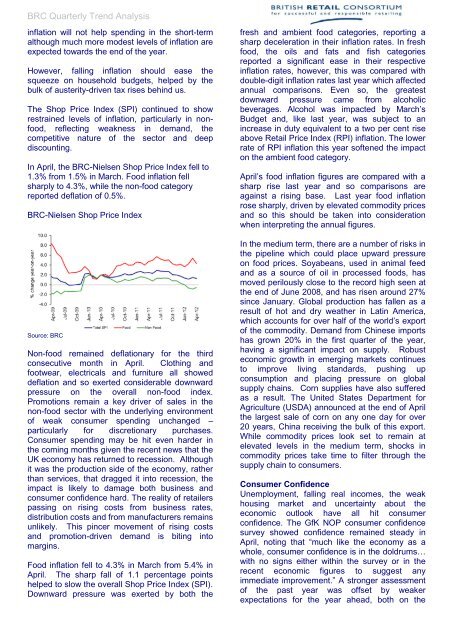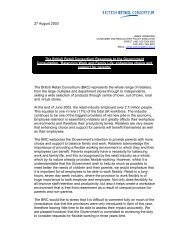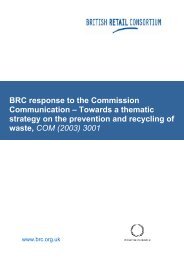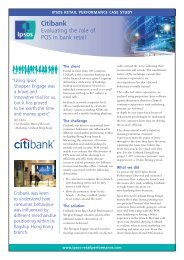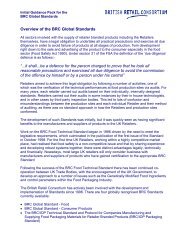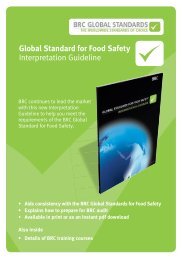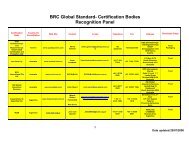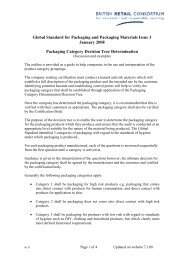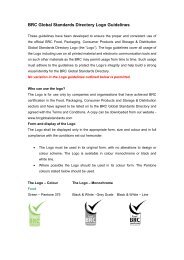BRC Quarterly Trend Analysis - British Retail Consortium
BRC Quarterly Trend Analysis - British Retail Consortium
BRC Quarterly Trend Analysis - British Retail Consortium
Create successful ePaper yourself
Turn your PDF publications into a flip-book with our unique Google optimized e-Paper software.
<strong>BRC</strong> <strong>Quarterly</strong> <strong>Trend</strong> <strong>Analysis</strong>inflation will not help spending in the short-termalthough much more modest levels of inflation areexpected towards the end of the year.However, falling inflation should ease thesqueeze on household budgets, helped by thebulk of austerity-driven tax rises behind us.The Shop Price Index (SPI) continued to showrestrained levels of inflation, particularly in nonfood,reflecting weakness in demand, thecompetitive nature of the sector and deepdiscounting.In April, the <strong>BRC</strong>-Nielsen Shop Price Index fell to1.3% from 1.5% in March. Food inflation fellsharply to 4.3%, while the non-food categoryreported deflation of 0.5%.<strong>BRC</strong>-Nielsen Shop Price IndexSource: <strong>BRC</strong>Non-food remained deflationary for the thirdconsecutive month in April. Clothing andfootwear, electricals and furniture all showeddeflation and so exerted considerable downwardpressure on the overall non-food index.Promotions remain a key driver of sales in thenon-food sector with the underlying environmentof weak consumer spending unchanged –particularly for discretionary purchases.Consumer spending may be hit even harder inthe coming months given the recent news that theUK economy has returned to recession. Althoughit was the production side of the economy, ratherthan services, that dragged it into recession, theimpact is likely to damage both business andconsumer confidence hard. The reality of retailerspassing on rising costs from business rates,distribution costs and from manufacturers remainsunlikely. This pincer movement of rising costsand promotion-driven demand is biting intomargins.Food inflation fell to 4.3% in March from 5.4% inApril. The sharp fall of 1.1 percentage pointshelped to slow the overall Shop Price Index (SPI).Downward pressure was exerted by both thefresh and ambient food categories, reporting asharp deceleration in their inflation rates. In freshfood, the oils and fats and fish categoriesreported a significant ease in their respectiveinflation rates, however, this was compared withdouble-digit inflation rates last year which affectedannual comparisons. Even so, the greatestdownward pressure came from alcoholicbeverages. Alcohol was impacted by March’sBudget and, like last year, was subject to anincrease in duty equivalent to a two per cent riseabove <strong>Retail</strong> Price Index (RPI) inflation. The lowerrate of RPI inflation this year softened the impacton the ambient food category.April’s food inflation figures are compared with asharp rise last year and so comparisons areagainst a rising base. Last year food inflationrose sharply, driven by elevated commodity pricesand so this should be taken into considerationwhen interpreting the annual figures.In the medium term, there are a number of risks inthe pipeline which could place upward pressureon food prices. Soyabeans, used in animal feedand as a source of oil in processed foods, hasmoved perilously close to the record high seen atthe end of June 2008, and has risen around 27%since January. Global production has fallen as aresult of hot and dry weather in Latin America,which accounts for over half of the world’s exportof the commodity. Demand from Chinese importshas grown 20% in the first quarter of the year,having a significant impact on supply. Robusteconomic growth in emerging markets continuesto improve living standards, pushing upconsumption and placing pressure on globalsupply chains. Corn supplies have also sufferedas a result. The United States Department forAgriculture (USDA) announced at the end of Aprilthe largest sale of corn on any one day for over20 years, China receiving the bulk of this export.While commodity prices look set to remain atelevated levels in the medium term, shocks incommodity prices take time to filter through thesupply chain to consumers.Consumer ConfidenceUnemployment, falling real incomes, the weakhousing market and uncertainty about theeconomic outlook have all hit consumerconfidence. The GfK NOP consumer confidencesurvey showed confidence remained steady inApril, noting that “much like the economy as awhole, consumer confidence is in the doldrums…with no signs either within the survey or in therecent economic figures to suggest anyimmediate improvement.” A stronger assessmentof the past year was offset by weakerexpectations for the year ahead, both on the


